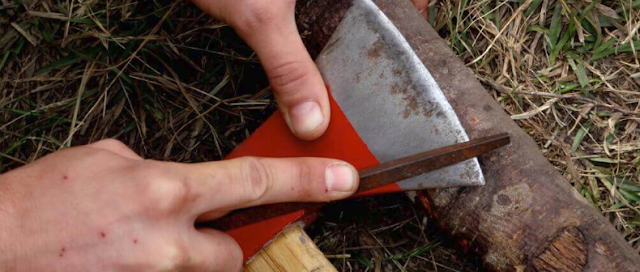✂️How to Safely Sharpen Your Lawn Mower Blade
If you're like me, you sometimes treat your lawn mower like an all-purpose yard mulcher, tackling tough twigs, flax leaves, and stray branches.
But after hitting a few hidden stones or accidentally running the blade over the concrete path, you're left with a dull blade that makes mowing the lawn a real chore.
A blunt blade doesn't just make more work for you; it's bad for your lawn's health.
This guide will walk you through everything you need to know to safely and effectively sharpen your lawn mower blade.
The Science: Why a Sharp Blade is Better for Your Lawn
A sharp mower blade cuts grass cleanly, like a pair of scissors. This allows the grass to heal quickly and grow healthily. A dull blade, on the other hand, tears and rips the grass blades.
This jagged damage creates a larger wound, which stresses the grass, makes it turn brown at the tips, and leaves it vulnerable to diseases and pests.
A sharp blade is the first step to a truly lush, healthy lawn.
The Golden Rule of Sharpening
There's an old saying: "If you have six hours to chop down a tree, spend the first four sharpening the axe."
The same principle applies here. A few minutes spent sharpening your mower blade will save you time and effort in the long run and give you a much better-looking lawn.
🛠️Method 1: Sharpening by Hand with a File
This is the classic, time-tested method. All you need is a good quality mill bastard file.
- Safety First: Disconnect the spark plug to prevent any accidental starts.
- Remove the Blade: Mark the downward-facing side of the blade with a Sharpie marker so you don't accidentally re-attach it upside down. Then, remove the blade from the mower.
- Secure the Blade: Clamp the blade securely in a vice.
- Sharpen at the Right Angle: Using your file, make firm strokes from the inside edge of the blade to the outside, maintaining a 45-degree angle.
- Check for Sharpness: Your blade is sharp enough when it feels like a butter knife. It doesn't need to be razor-sharp; the force of the spinning blade does most of the work.
- Reinstall Correctly: Reinstall the blade the right way up. Seriously, check your mark!
⚙️Method 2: Sharpening with a Drill Attachment
You can use your trusty drill to sharpen your blade with the right sharpening attachment. These are typically made of a hard, abrasive material like corundum and can be found cheaply on Amazon.
- Prepare the Blade: As before, disconnect the spark plug, mark the blade, and clamp it securely in a vice.
- Put on Your Safety Glasses! This is non-negotiable when using power tools.
- Line It Up: The sharpening stone attachment will have a guide. Line this up with the existing bevel on your blade.
- Use Light Pressure: Let the tool do the work. Use a light, even pressure as you run the drill along the blade's edge.
- Flip and Repeat: Flip the blade over in the clamp and repeat the process on the other side.
This video tutorial shows an excellent method on how to sharpen the blade safely using a drill:
You can also use a rotary tool like a Dremel, an angle grinder, or a belt sander in a similar fashion. Just be extremely careful and always prioritize safety.
⚖️The Crucial Final Step: Balancing Your Blade
The Science of Blade Balance
After sharpening, your blade must be properly balanced. An unbalanced blade will vibrate violently when spinning at high RPMs.
This vibration can cause severe damage to your mower's engine and crankshaft over time due to the unstable gyroscopic forces. Balancing ensures the weight is evenly distributed, leading to a smooth, quiet, and safe operation.
You can test the balance with a blade-balancing tool, or you can use the classic trick of hammering a nail partway into a wall and hanging the blade from its center hole.
If it hangs horizontally, it's balanced.
If one side dips, you need to remove a small amount of metal from the heavy side. Always file from the back edge of the blade, not the cutting edge, to make adjustments.
❓Frequently Asked Questions
How often should I sharpen my mower blade?
Many users sharpen their blades at the beginning of every grass-growing season. It never hurts to check it periodically, especially if you've hit a few rocks or mulched a lot of woody debris.
My blade is pretty damaged. What can I do?
If your blade has significant nicks, cuts, or is bent, it's time to replace it. A damaged blade will never cut efficiently and can be a safety hazard. You can find plenty of replacement blades on Amazon. Just make sure to order the correct size for your mower!
Can I put a mulching blade on my mower?
Yes! If you want your mower to do some heavy-duty mulching, you can install a specialized mulching blade. These blades have a more curved design with extra cutting surfaces to chop grass clippings into fine pieces. Just be aware that you may need to sharpen a mulching blade more regularly than a standard blade.


